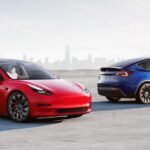Nissan Motor Corporation recently unveiled a range of new and refreshed models that are set to hit global markets in the next two years. This move comes as the struggling Japanese automaker aims to regain its footing after the collapse of merger talks with Honda earlier this year. The new product plans were introduced to instill confidence in the company’s future product strategy amidst mounting challenges in the automotive industry.
The company is currently facing stiff competition from Chinese automakers, the rapid shift towards zero-emission vehicles, and escalating import tariffs in the US. With a reported net loss in the third quarter of the current fiscal year, Nissan’s outlook remains uncertain. To address these issues, Nissan’s newly appointed CEO, Ivan Espinosa, has been tasked with cutting costs and reviving the company’s performance.
As part of its restructuring efforts, Nissan has decided to further loosen its ties with Renault Group, its largest shareholder. This includes selling its majority stake in the Indian joint venture, Renault Nissan Automotive India Private Ltd, to Renault. This move will free up cash for Nissan but will also make it a customer of the manufacturing operation in Chennai. The two companies will continue their joint model sharing and development plans, with Nissan retaining a stake in their Renault Nissan Technology & Business Center India joint venture.
Additionally, Nissan has been released from its commitment to invest in Renault’s Ampere battery electric vehicle company. The two companies have also agreed to reduce their minimum shareholding in each other as part of a relaunched “New Alliance Agreement.” Despite these changes, Nissan intends to maintain its collaboration with Honda on various projects, including the development of battery electric vehicles, hybrid technologies, and autonomous driving technologies.
Nissan also plans to continue its partnership with Mitsubishi Motors, particularly in the Asia-Pacific region, to capitalize on product development and production synergies. Furthermore, the company remains open to forming alliances with other automakers on a project-by-project basis, including Taiwan’s Hon Hai Precision Industry Company (Foxconn).
In an effort to streamline decision-making and speed up new product development cycles, Nissan has transitioned to a single-layer top management structure and reduced the number of top executive positions. This restructuring is expected to enhance efficiency and agility within the company.
On the product front, Nissan’s Chief Performance Officer, Guillaume Cartier, outlined the company’s new product strategy for the next two years. This includes the launch of a third-generation Nissan Leaf battery-powered crossover vehicle, built on Nissan’s modular CMF-EV platform. The company also plans to introduce a third-generation e-POWER hybrid system, offering improved fuel economy and lower emissions.
In various regions, Nissan will roll out a range of new and refreshed models, including EVs, hybrids, and SUVs, over the next two years. These models will cater to diverse customer preferences and showcase Nissan’s commitment to innovation and excellence in the automotive industry.
Overall, Nissan’s new product strategy signals a fresh direction for the company as it navigates the challenges of the global automotive market. With a focus on innovation, efficiency, and customer satisfaction, Nissan is poised to make a strong comeback and solidify its position as a key player in the industry.







